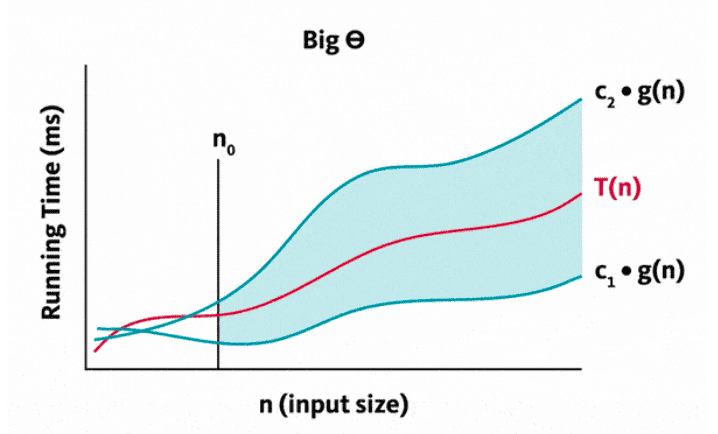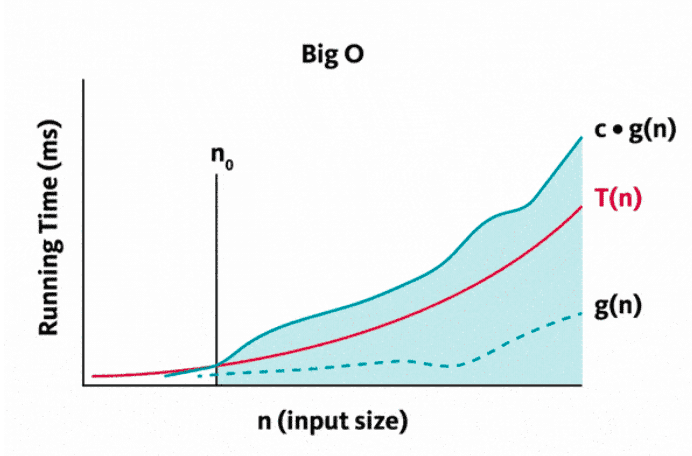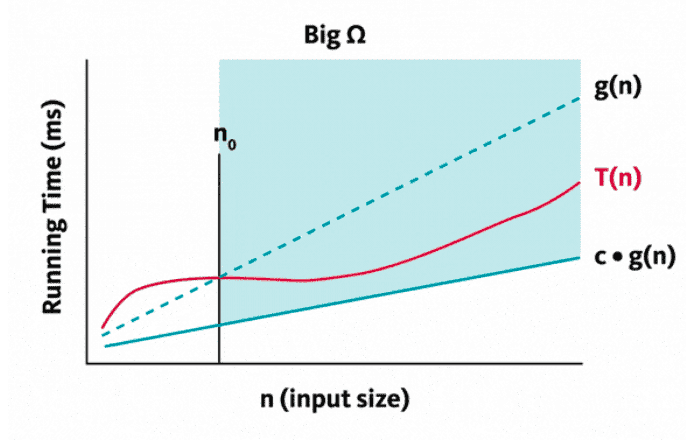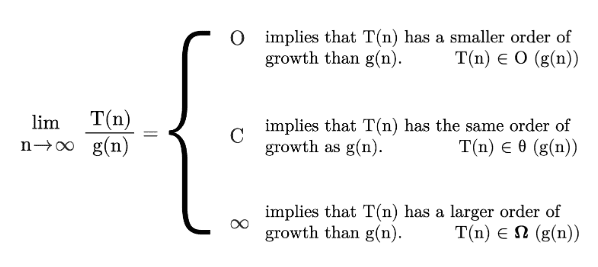asymptotic notation of algorithms
Asymptotic is the behavior of a line as itt approaches a curve but never touches it. In analyzing efficiency we want to know how running time increases as size of input increases without bound. This uses big-O, omega, and theta.
This is where T(n) and g(n) can be any nonnegative functions defined as positive integers.
T(n)- running timeg(n)- Some simple function to compareT(n)with
O Notation (Big O)
Informally, O(g(n)) is a set of all functions with a lower or same order og frowth as g(n)
within a constant multiple, as n goes to infinity.
We can say T(n) is O(g(n)) if T(n) exists in O(g(n))
This can be expressed graphically, where c is a positive constant
Formal expression:
- A function
T(n)is said to be inO(g(n)), denoted by
T(n) ∈ O(g(n)), if T(n) ≤ c(g(n)) for all n ≥ n0, for some positive constant c.
Ω Notation (Omega)
Informally, Ω(g(n)) is a set of all functions with a higher or same order of
growth as g(n) (within a constant multiple, as n goes to infinity).
we say a function T(n) “is Ω(g(n))” if T(n) ∈ Ω(g(n)).
This can be expressed graphically, where c is a positive constant
Formal expression:
- A function
T(n)is said to be inΩ(g(n)), denoted by
T(n) ∈ Ω(g(n)), if T(n) ≥ c(g(n)) for all n ≥ n0 , for some positive constant c.
Θ Notation (Theta)
Informally, Θ(g(n)) is a set of all functions that have the same order of growth
as g(n) ( bounded both above and below by some positive constant multiples of g(n),
as n goes to infinity)
We say a function T(n) “is Θ(g(n))” if T(n) ∈ Θ(g(n)).
This can be expressed graphically, where c is a positive constant
Formal expression:
- A function
T(n)is said to be inΘ(g(n)), denoted byT(n) ∈ Θ(g(n)), if c1 g(n) ≤ T(n) ≤ c2 g(n) for all n ≥ n0,
for some positive constants c1 and c2.
This seems to be a wavier graph that might have tigher bounds (more accurate?).

Comparing orders of growth
We can use formal definitions of O, omega, and theta but computing the limit of the ratio of 2 functions is more convenient.
Limits example shown here:
The limit based approach is convenient because it benefits from techniques in calculus.
Note:
f(n)∈ Θ(g(n))impliesf(n) = O(g(n))andf(n) = Ω(g(n))since theta notation
is stronger notation than O- and Ω-notation
Properties involving asymptotic notations
f(n) ∈ Θ(g(n)) O(g(n)) Ω(g(n))
- Transitivity
f(n) = Θ(g(n))andg(n) = Θ(h(n))implyf(n) = Θ(h(n))f(n) = O(g(n))andg(n) = O(h(n))implyf(n) = O(h(n))f(n) = Ω(g(n))andg(n) = Ω(h(n))implyf(n) = Ω(h(n))
- Reflexivity
f(n) = Θ(f(n))f(n) = O(f(n))f(n) = Ω(f(n))
- Symmetry
f(n) = Θ(g(n))if and only ifg(n) = Θ(f(n))
- Transpose symmetry
f(n) = O(g(n))if and only ifg(n) = Ω(f(n))


